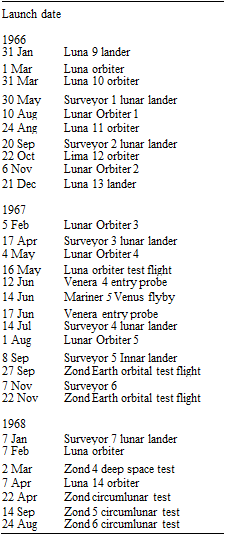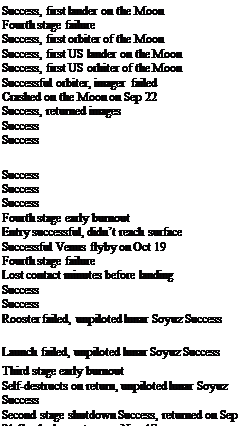Finally success at the Moon and Venus, but Mars eludes
TIMELINE: JAN 1966-NOV 1968
The race to put humans on the Moon heated up in 1966. Both the Soviets and Americans stepped up the pace of their robotic lunar missions in support of eventual manned missions, with each successfully sending landers and orbiters. In September 1967 the Soviets began automated tests of a version of the Soyuz spacecraft that was intended to fly cosmonauts on circumlunar missions. In September 1968 the Zond 5 mission flew this spacecraft around the Moon and returned to Earth with a biological payload and high quality photographs of Earth from deep space. Its success spurred the American decision to send Apollo 8 into lunar orbit in the hope that astronauts would beat cosmonauts to the vicinity of the Moon. The Soviets lost their chance in November, when Zond 6 flew a repeat of the circumlunar mission and crashed on its return. This left the way clear for Apollo 8 in December, whose success nullified the propaganda value to be gained from sending cosmonauts on a circumlunar mission.
On their first launch of 1966 the Soviets were finally successful with their Luna soft-lander series. Luna 9 became the first lander on the Moon on February 3. It was followed in December by a second lander. Luna 13. Immediately after the success of Luna 9 an orbital module was hastily assembled to replace the lander module, and the spacecraft converted to support the call by the manned program for information on the lunar gravity field and surface properties. With the Luna 10 mission launched on March 31, 1966, the Soviet Union became the first nation to put a spacecraft into orbit around the Moon. Additional orbiters were sent, and by the close of 1968 this series was concluded with Luna 14.
On May 30,1966, America succeeded with its first attempt at a lunar soft landing. Surveyor 1 was a more sophisticated lander than Luna 9, as were the spacecraft of its Lunar Orbiter series, the first of which was successfully inserted into orbit around the Moon in August 1966. The purpose of the US landers and orbiters was precisely
W. T. Huntress and M. Y. Marov, Soviet Robots in the Solar System: Mission Technologies and Discoveries, Springer Praxis Hooks 1, DOl 10.1007/978-1-4419-7898-1 10,
© Springer Science+Business Media, LLC 2011
 |
 |
the same as their Soviet counterparts, to determine the properties of the Moon and to identify candidate landing sites for manned missions. All five Lunar Orbiters were successful, as were five of the seven Surveyor landers.
In the midst of all this lunar activity, the Soviets had their first fully successful planetary mission, launched as Venera 4 on June 12, 1967. A second launch on June 17 was unsuccessful. Venera 4 entered the atmosphere of Venus on October 18 and transmitted atmospheric data while descending by parachute until it fell silent at an altitude that was still far above the surface. The next day America made its second successful flyby mission of Venus, with Mariner 5.
Both the nations ignored the Mars launch opportunity in 1967. The US could not afford as many launches as the Soviets and focused on Venus in 1967. The Soviets, frustrated by their six failures at Mars, by their continuing difficulties with the 3MV spacecraft, and by the Mariner 4 flyby in 1965. decided to forego the 1967 window and create a more complex Mars spacecraft that would be dispatched by the Proton launcher on a mission to land on the planet. In contrast, the tantalizing performance of Venera 2 and 3 ensured that this ЗМ V line would continue for Venus, and after the success of Venera 4 it became evident that a landing on the surface of that planet was achievable.










